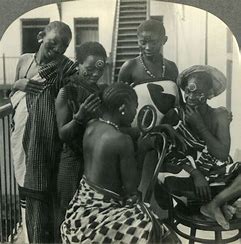
One thousand years ago, East Africa’s Swahili coast was a key node in a trade network that linked merchants from Africa, the Middle East and South Asia, propelled by the monsoon winds.
Out of this melting pot emerged hints of a new culture, as prosperous ‘stone towns’, with mosques and homes built from coral blocks, flourished along the coast from southern Somalia to northern Mozambique.
Ancient genomes from dozens of individuals buried in these medieval settlements now point to the diverse origins of Swahili culture, with people carrying a mix of local African, Middle Eastern and South Asian ancestry.
“It’s mind blowing for me,” says Diyendo Massilani, an ancient-DNA specialist at Yale School of Medicine in New Haven, Connecticut, who was not involved in the work published on March 29 in Nature. “People from Asia and people from Africa come together and build a new culture, a new society.”
Today, millions of people identify as Swahili; most live in coastal East Africa. How these modern people are related to the medieval inhabitants of the Swahili coast has not been clear.
Colonial archaeologists who excavated settlements such as Kilwa, an island town off the coast of Tanzania, contrasted the area’s extravagant mosques and homes with more temporary structures found inland, and concluded that the stone towns were created by Middle Eastern people.
“The idea that Swahili civilisation is essentially an Arab civilization took root in writings by virtually of all the Europeans who passed through the area,” says Chapurukha Kusimba, an anthropological archaeologist at the University of South Florida in Tampa who co-led the study.
Since the 1980s, Kusimba, who is from Kenya and other post-colonial archaeologists working at the medieval Swahili settlements have found abundant evidence of African influences, such as mortuary practices and pottery. To pinpoint the origins of the towns’ inhabitants, Kusimba and his colleagues turned to ancient DNA, after gaining permission to take samples from human remains from cemeteries at several medieval Swahili sites. “You want to know the truth of the people who created this civilisation, let’s dig them up,” he says.
The researchers sampled DNA from 54 people who were buried in Swahili coastal towns in Kenya and Tanzania, as well in an inland burial in Kenya, between 1,250 and 1,800. Analysis of the DNA showed that most of the sampled medieval Swahili coast individuals were descended from people from East Africa, Persia (now Iran) and South Asia, who began mixing around AD 1,000.
They also discovered a strong sex bias in the ancestry patterns. Nearly all the East African ancestry seemed to come from women, whereas most of the Asian ancestry was contributed by men from Persia.
It was not clear whether there was a strong sex bias in South Asian ancestry, which was present at lower levels than Persian and African ancestry and absent in some Swahili coast individuals. However, two related people whose DNA was found at a Kenyan site carried maternally inherited mitochondrial DNA markers found in India, suggesting that some South Asian women settled in East Africa.
Long-established Indian Ocean trading networks linking Africa, the Middle East and South and southeast Asia probably explain the diverse ancestry of medieval Swahili coast people, says David Reich, a population geneticist at Harvard Medical School in Boston, Massachusetts, who co-led the study.
Male merchants from Persia might have solidified trading relationships by marrying into the families of East African traders, he says.
The genetic findings lend support to oral traditions of Swahili people that trace the origins of the medieval towns to the arrival of Persian merchants. “It’s easy to discount oral history as ‘just stories’, but it aligns pretty well with our results,” says team member Esther Brielle, a population geneticist at Harvard Medical School.
Mark Horton, an archaeologist at the Royal Agricultural University in Cirencester, UK, says the ancient-DNA results should be interpreted with care. The study took most of its samples from individuals buried inside the Swahili coast stone towns, and he wonders whether the genomes of those buried outside the walls might tell a different story. He also points out that there are signs of Swahili culture that pre-date the arrival of Persian ancestry by hundreds of years.
The study “contributes significantly to solving some of the puzzles we’ve held for quite some time”, says Elgidius Ichumbaki, a coastal archaeologist at the University of Dar es Salaam in Tanzania. But he suspects these are only part of the larger puzzle. Roman ceramics from before arrival of Persian ancestry have been found at sites along the Swahili coast, Ichumbaki says. “Any idea about the interactions before AD 1000 would really be meaningful and should be the next steps.”
- A Nature report











